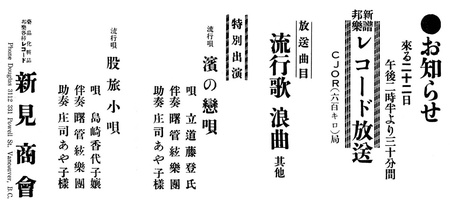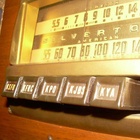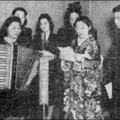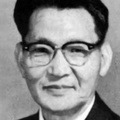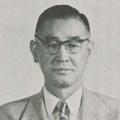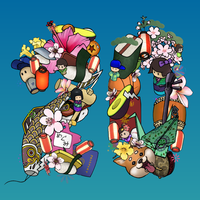In the third installment, we will write about Niimi Shokai's "Popular Song Broadcasting," which is a rival to Japanese Song Broadcasting.
Niimi Shokai was a drugstore and photo shop run by Niimi Toragoro (born in Tokushima Prefecture and arrived in Japan in 1910), which opened at 331 Powell Street in 1919. It advertised almost daily in the Japanese language newspaper Tairiku Nippo. It later began selling Japanese records, gramophones, and radios. Wind-up gramophones, which did not require a power source, were loaded onto fishing boats and were popular among fishermen as entertainment during breaks from fishing.
Niimi Shokai celebrated the launch of Shinkosha programs in an advertisement in the July 19th, 1935 edition of the Continent Nippo newspaper with the headline "Congratulations: The start of late-night Japanese broadcasting," and also promoted radio receivers. On January 19th, 1936, from 4:15 p.m. for 30 minutes, Niimi Shokai began a "popular song broadcast" provided by their company on station CJOR.
Niimi reminisced about this program, "When I think back on it, I was an amateur and it made me break out in a cold sweat" (North American Centennial Cherry Blossoms (3)). This suggests that the store owner himself was in charge of the announcements in the early days, but from at least the third episode onwards, Niimi Shokai's head clerk, Okamoto Hideo, took over as announcer.
Program Contents
In terms of programming, there was a big difference between Niimi and its rival Shinkosha program at the time. Whereas Shinkosha put live music at the forefront, Niimi Shokai focused on records, but also incorporated live performances as special appearances. It seems that Niimi Shokai took advantage of the fact that they sold Japanese records in their store, and used it to advertise their products. For live performances, Kintaro Emiko and Tamagawa Yuriko, the proprietresses of a traditional restaurant who are familiar faces on Shinkosha Broadcasting, played the shamisen and made a big impact from the first episode.
The program schedule for the first day is as follows:
"Green Horizon" (Kusunoki Shigeo), "The Boatman is Lovely" (Otomaru), "Twilight Hell" (Tokairin Taro), "Song of Hell" (Takemoto Fumiko solo, accompaniment by Kintaro Emiko and Tamagawa Yuriko), "Longing for the Willow Tree" (Tokairin Taro), "Rafting" (Otomaru), "Aizu Bandai Mountain" (Shimeka), "Hakata Girl's Wave Pillow" (Tokairin Taro), "That is also a Memory" (Tokairin Taro, Matsushima Utako)
Of the nine songs, eight were recorded using records imported from Japan.
The third broadcast was on May 10th from 6:00pm to 6:30pm on CKMO station. The content included popular songs, movie reviews, Naniwabushi records, and special appearances. Special appearances are treated as the best thing to do that day, and on this day, Takemoto Fumiko and Watase Kinichi performed "Bankoba [Vancouver] Ondo" for the first time, which was a big hit.
From September 1936, the Akebono Orchestra was credited as the accompanist for special appearances. In 1937, Nishihama Toyokazu was the chairman and manager, and Okawara Kaoru Cecil was the director. The orchestra made the debut of many singers, mainly newcomers. In 1936, they made their debuts with Tatedo Fujito, Shimazaki Kayoko, Kumi Sonoko, and Kamo Kyoko; in 1937, they made their debuts with Kosaka Fumiko, Aoba Shigeo, Okazaki Mary, Komatsu Midori, Shima Haruki, Takase Ginko, Sugimoto Taichi, and Ichijo Sumire; in 1939, Terakita Fujie; and in 1940, Sakai Iwaichi, Homma Kei, Shishido Hisako, and Sugimoto Taichi. Of these, Shimazaki Kayoko and Kosaka Fumiko were made the exclusive singers of the orchestra. They also made use of veteran singers such as Nakatsu Teruo and Takemoto Fumiko. This program was unique in that it provided a valuable opportunity for music-loving young people in the Japanese community to perform, even if they were not fully-fledged vocalists.
In the 1937 and 1938 programs, records of manzai (comic comedy, by Sunagawa Sutemaru and others), Naniwabushi, movie commentary, and rakugo (by Yanagiya Kingoro) were broadcast along with songs. On September 26, 1937, the local song "Powell Kouta" sung by Takemoto Fumiko and Shima Haruki was broadcast. This was a great service that was close to the local area and was unique to Japanese broadcasting, something that could not be achieved with Japanese records.
After a gap of about two years, a 30-minute program was broadcast on December 24, 1939. However, from the statement "Japanese music is OK, but the introductions will only be in English" (Tairiku Nippo, December 23, 1939), it can be seen that Japanese broadcasts were no longer possible. Sasaki Mitsue was in charge of the English announcements. On this day, Terakita Fujie sang "Satoren Toge," "Otone Tsukiyo," "Aizen Soushi," and other songs accompanied by Handa Sally, Niimi Etsuko, and Kamata Tamae. In addition to music, the 1940 broadcast also aired announcements about a Red Cross support concert organized by the Japanese Canadian Citizens League (JCCL) and Canada national bonds.
The program was quickly revived to a monthly broadcast, with the final episode airing on February 25, 1940. Coincidentally, just like Shinkosha, it was broadcast 20 times in total. Until the very end, the program maintained its style of broadcasting two or three songs performed live by the Akebono Orchestra.
Japanese Broadcast Rating
Regarding how Japanese language broadcasting was received by Japanese immigrants, Yamamoto Michiyoshi wrote the following in a Japanese newspaper:
"I have heard that our compatriots active in the countryside eagerly await the first Japanese broadcast, and in some places, when the broadcast actually begins, they even take time off work and gather around the radio in a frenzy. In that sense, the Japanese broadcast can be said to be an excellent event for the comfort of our compatriots." (Continental Daily News, May 17, 1937)
These words must have been very encouraging for those broadcasting the program.
*This article is reprinted from the monthly magazine " Freezer " (April 2022 issue).
© 2022 Tetsuya Hirahara


